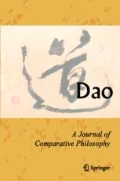References
Analects. In Lau.
Allinson, Robert Elliot. 2003. “Hillel and Confucius: The Prescriptive Formulation of the Golden Rule in the Jewish and Chinese Confucian Edthical Traditions.”Dao: A Journal of Comparative Philosophy 3. 1: 29–41.
Berthrong, John. 1994.All Under Heaven—Transforming Paradigms in Confucian Christian Dialogue. New York: SUNY Press.
Buber, Martin. 1967a. “The Spirit of the Orient and Judaism.” InOn Judaism. Ed. by Nahum N. Glatzer. New York: Schocken Books.
—. 1967b. “The Holy Way: A Word to the Jews and to the Nations.” InOn Judaism. Ed. by Nahum N. Glatzer. New York: Schocken Books.
Cohen, Abraham. 1949.Everyman’s Talmud—The Major Teaching of the Rabbinic Sages. New York: Schocken Books.
Chan, Wing-tsit, ed. 1963.A Source Book in Chinese Philosophy. Princeton: Princeton University Press.
Ching, Julia. 1977.Confucianism and Christianity. Tokyo: Konansha International.
de Bary, William Theodore. 1991.The Trouble with Confucianism. Cambridge, MA: Harvard University Press.
Irene Eber. 1993. “K’aifeng Jews Revisited: Sinification as Affirmation of Identity.”Monumenta Serica 41: 231–247.
—. 1999.The Jewish Bishop and the Chinese Bible, S.I.J Schenschewsky (1831–1906). Leiden: E.J. Brill.
—. 2000. “Flight to Shanghai 1938–1939 and Its Larger Context” InJews in China: From Kaifeng…to Shanghai. Ed. by R Maleck. Germany: Monumenta Serica Monograph Series XLVI: 416–435.
—. 2002.Chinese and Jews: Encounters Between Cultures. Jerusalem: Bialik
-. 2004. “Martin Buber and Chinese Thought” (a paper at the Frankfurt Meeting, July).
-. 2005.Overland and by the Sea—EightCenturies of Jewish Presence in China. Forthcoming in Hebrew inMoreshet Israel.
Friedländer. 1956.The Guide for the Perplexed by Moses Maimonides. New York: Dover Publications Inc.
Goldman, Rene. 1995. “Moral Leadership in Society: Some Parallels between the Confucian ‘Nobleman’ and the Jewish Zaddik.”Philosophy East and West 45. 3: 329–365.
Hall, David L., and Roger T. Ames. 1987.Thinking Through Confucius. Albany: SUNY Press
Klein-Braslavy, Sara. 1986.Maimonides Interpretations of the Adam Stories in Genesis—A Study in Maimonides Anthropology. Jerusalem: Reuven Mass.
Lau, D.C., trans. 1979.Confucius The Analects. London: Penguin Books.
Leslie, Donald Daniel. 1972.The Survival of the Chinese Jews—The Jewish Community of Kaifeng. Leiden: E. J. Brill.
Maimonides(Rambam), Moses. 1961.Moreh Nevukhim: perushim melukatim, me’et Efodi Shem-Tov, Kreskas Abarbanel. Translated to Hebrew by Shmuel Ibn Tibon. Jerusalem: Barazani.
Patt-Shamir, Galia. 2004. “Seeds for Dialogue: Learning in Confucianism and Judaism.”Journal of Ecumenical Studies 40. 1–2: 201–215.
Pollak, Michael. 1983.Mandarins, Jews and Missionaries: The Jewish Experience in the Chinese Empire. Philadelphia: Jewish Publication Society of America.
Sacks, Jonathan. 1992.Crisis and Covenant—Jewish Thought after the Holocaust. New York: Manchester University Press.
Sharpre, Eric J. 1975. “Toward a Dialogue of Religions?” InComparative Religion—A History. La Salle: Open Court.
Scholem, Gershom. 1995.MajorTrends in Jewish Mysticism. New York: Schocken Books.
Steinsaltz, Rabbi Adin. 1980.The Thirteen Petal Led Rose—A Discourse on the Jewish Existence and Belief. New York: Basic Books.
—. 1989.The Talmud—The Steinsaltz Edition. New York: Random House.
Tu, Wei-ming. 1989.Centrality and Commonality—An Essay on Confucian Religiousness. New York: SUNY Press.
—. 1993a. “Confucianism.” InOur Religions. Ed. by Arvind Sharma. San Francisco: Harper San Francisco.
—. 1993b.Way, Learning, and Politics—Essays on the Confucian Intellectual. New York: SUNY Press.
—. 2001. “Multiple Modernities: A Preliminary Inquiry into the Implications of East Asian Modernity.” InCulture Matters: How Values Shope Human Progress. Ed. by Lawrence E. Harrison and Samuel P. Huntington. New York: Basic Books.
Weber, Max. 1968.The Religion of China: Confucianism and Taoism. Trans. and ed. by H. H. Gerth. Glencoe, IL: Collier-Macmillan.
Zhang, Ping. 1999. Bridging Between the Actual and the Ideal in Early Rabbinical and Confucian Literature. PhD dissertation. Tel-Aviv University.
Zhou, Dunyi. 1937.Book of Comprehensiveness. InComplete Works of Zhou Lianxi. Shanghai: Shangwu Yinshuguan.
Zhu, Xi. 1970.Classified Sayings. Taibei: Zhengzhong Shuju.
Author information
Authors and Affiliations
Corresponding author
Rights and permissions
About this article
Cite this article
Patt-Shamir, G. Way as dao; way as halakha: Confucianism, Judaism, and way metaphors. Dao 5, 137–158 (2005). https://doi.org/10.1007/BF02857008
Issue Date:
DOI: https://doi.org/10.1007/BF02857008

